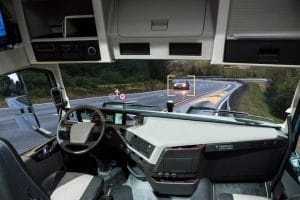The Dangers of Autonomous Trucks
 The image of the truck driver, especially long-haul truckers, is one that is in many ways synonymous with America’s highway system. It is easy to picture: A driver traveling the open road in a big rig, communicating with other truckers via CB radio as they all crisscross the country to deliver vital consumer goods to locations throughout Texas and beyond. It all sounds great – unless you have the misfortune of being in an accident with a tractor-trailer. Especially if you are in a passenger vehicle.
The image of the truck driver, especially long-haul truckers, is one that is in many ways synonymous with America’s highway system. It is easy to picture: A driver traveling the open road in a big rig, communicating with other truckers via CB radio as they all crisscross the country to deliver vital consumer goods to locations throughout Texas and beyond. It all sounds great – unless you have the misfortune of being in an accident with a tractor-trailer. Especially if you are in a passenger vehicle.
This is a legitimate concern in Texas. According to the Federal Bureau of Labor Statistics, Texas boasts the highest employment level in heavy and tractor-trailer truck drivers with more than 200, 000. That means a lot of trucks traveling into, out of, and around the Lonestar State. It also means an increased risk of truck accidents in Texas.
The impending rise of autonomous trucks is being touted as a real win-win for everyone. Driverless trucks will be more efficient, experts claim, as the artificial intelligence operating the big rig will not require sleep like a human driver and therefore will not be limited in the number of hours it can spend on the road. More importantly, say proponents of autonomous trucks, roads will be safer because autonomous technology will eliminate or significantly reduce the human errors that are so often to blame in truck accidents. Autonomous trucks would mean no more truck drivers hitting the road on too little sleep, getting distracted while driving, or making mistakes or poor decisions that lead to devastating accidents. But are these safety claims true? Some experts are sounding the alarm regarding the safety of autonomous trucks.
Why are autonomous trucks dangerous?
Autonomous vehicle technology is already responsible for many of the features drivers enjoy in vehicles today, such as lane assist and self-parking. This is just the tip of the technological iceberg, so to speak. The National Highway Traffic Safety Administration (NHTSA) has six levels of automation, ranging from Level 0 which involves no automation to Level 5 which is full automation.
In Levels 1 through 4, human drivers are required to operate the vehicle in varying degrees. For instance, in Level 3 and Level 4, the truck essentially “drives itself” most of the time, but a licensed truck driver must be present in the truck at all times and capable of taking over driving at a moment’s notice. This presents some challenges because a person who is not driving may find it more challenging to keep their attention on the road. If a situation occurs that requires the person to take control of the truck, they may not be paying attention or it may take them crucial seconds to assess the situation and react appropriately. This can put everyone on the road in danger.
By Level 5 on the NHTSA’s automation scale, humans are considered passengers and are not required to be capable of operating the vehicle for any reason.
The sheer size and weight of tractor-trailers means they are always a threat to smaller vehicles such as cars, pickup trucks, and SUVs – regardless of who or what is operating the truck. Similar to big rigs operated solely by human drivers, tractor trailers operated using artificial intelligence and machine learning have the potential to be involved in serious crashes. When a crash does occur, the end result can be tragic. Severe injuries like broken bones, burns, and soft tissue damage may occur, as may catastrophic injuries such as spinal cord injuries (SCI), traumatic brain injuries (TBI), and traumatic loss of limbs. It may even be fatal – the Federal Motor Carrier Safety Administration reports that in 2019, 82% of fatalities in crashes involving large trucks and passenger vehicles were not occupants of the large truck.
What causes autonomous truck accidents?
Despite the many safety claims regarding autonomous vehicles, including autonomous trucks, these technologically advanced vehicles are not immune to accidents. In fact, autonomous trucks can cause or be involved in accidents for a variety of reasons, such as:
- Software Malfunctions. When an autonomous truck causes an accident, a software malfunction is typically to blame. For instance, if the software does not recognize a potentially hazardous situation and thus does not adjust accordingly the way a human driver would. This can lead to a potentially deadly accident.
Perhaps just as frightening, autonomous trucks can be hacked, with someone remotely taking control of the vehicle via the truck’s computer system. This can turn the truck into a weapon. Considering the fact that a fully loaded tractor trailer can weight approximately 80,000 pounds, this is a significant threat.
- Driver Error. Autonomous trucks are still in the first three levels of automation, meaning a human driver is required to be in the truck so they can take over control of the vehicle in the event of a malfunction or hazard in the roadway. If the driver is distracted, it may take them a moment to get their bearings and take control of the truck. This may take a moment too long when every second counts.
- Locational Hazards. Anything can happen on a highway: unanticipated roadway conditions such as ice, a vehicle suddenly stopping in the roadway, or large animal unexpectedly wandering onto the road. Combine any of these scenarios with the high rate of speeds autonomous trucks typically travel at while operating on an open highway and the consequences can be deadly. If a human operator is in the truck when this occurs, the truck’s speed may make it difficult for them to quickly take control of the truck and maneuver it around any obstacles or to a safe stop.
- Negligence Related to Maintenance or Loading. The best technology in the world is irrelevant if a trucking company fails to properly maintain its vehicles and does not adhere to all relevant requirements and restrictions regarding the truck’s cargo. Accidents can occur due to:
- Brake failure
- Broken headlights or taillights
- Improperly loaded cargo
- Rearguard failure
- Steering component issues
- Suspension failure
- Tire blowouts
- Transmission failure
Any of these issues can lead to serious accidents such as:
- Head-on collisions
- Jackknife accidents
- Rear-end collisions
- Underride accidents
Were you hit by an autonomous truck?
If you or a loved one were injured in a truck accident involving an autonomous truck, it is crucial that you speak with a truck accident attorney who understands autonomous technology. Like any truck accident, those involving self-driving trucks can cause deadly or catastrophic accidents that leave the victims and their loved ones suffering for years. Trucking companies and those responsible for creating, installing, and maintaining the technology must be held accountable in order to protect everyone on the roads.
The Texas truck accident lawyers at Slack Davis Sanger know that both the technology and laws related to autonomous trucks are constantly evolving. We make a point of staying on top of these developments, ensuring that we are prepared to negotiate high settlements and secure strong verdicts for our clients. From our offices in Austin, Dallas, and Fort Worth, our autonomous truck accident lawyers represent truck accident victims throughout Texas. Call us at 800-455-8686 or complete our contact form today to schedule an appointment.

The firm handles cases involving catastrophic personal injuries and deaths. Our work spans three decades of handling airplane and helicopter crashes, truck and car accidents, oilfield and construction accidents, and other devastating accidents. We try lawsuits throughout the country in both federal and state courts and have recovered hundreds of millions of dollars for our clients. To date, we have handled or tried cases in 47 states, read more about our attorneys and firm.
